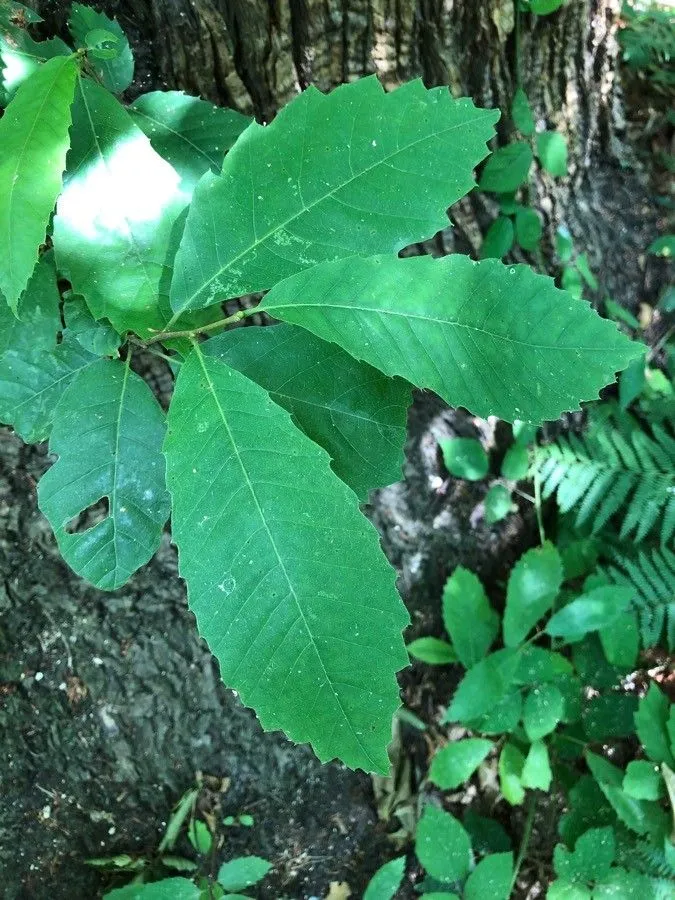
Author: (Marshall) Borkh.
Bibliography: Theor. Prakt. Handb. Forstbot. 1: 741 (1800)
Year: 1800
Status: accepted
Rank: species
Genus: Castanea
Vegetable: Unknown
Observations: E. Canada to NC. & E. U.S.A.
The American chestnut, scientifically referred to as Castanea dentata, stands as a majestic specimen within the diverse family of Fagaceae. First documented in 1800 within the renowned botanical work “Theor. Prakt. Handb. Forstbot.” authored by Marshall, later classified by Borkh, this tree once thrived expansively across eastern regions of Canada and the United States, ranging from parts of North Carolina to the vast expanses of the Northeastern United States.
This towering deciduous tree, distinguished by its robust, straight trunk and broad leafy crown, symbolizes one of the finest representatives of temperate forest flora. Historically, the American chestnut was not only a keystone species within its habitat but also a valuable resource for both wildlife and human populations. The tree’s nuts served as an essential food source, while its durable wood was prized for its resistance to decay, making it an excellent choice for building material and furniture.
The American chestnut’s leaves are typically elongated and serrated, rendering it distinctive among its kin. Each leaf’s beautiful, toothed edges capture the unique essence of this species, a characteristic that is echoed in its scientific nomenclature, ‘dentata,’ meaning ‘toothed’ in Latin. During flowering season, the tree produces long catkins that enhance the forest with their delicate and subtle presence.
However, the story of the American chestnut is tinged with tragedy. In the early 20th century, a devastating blight caused by the Cryphonectria parasitica fungus swept through the natural range of this species, leading to widespread loss and devastating its population. Efforts to combat this blight and restore the species are ongoing, involving cross-breeding and gene-editing techniques to produce blight-resistant trees.
Despite past and ongoing challenges, the American chestnut remains a symbol of resilience and hope. Conservation endeavors strive to return this iconic tree to its rightful place within the North American forests. The American chestnut continues to serve as an emblem of ecological restoration and a reminder of the intricate interdependencies within our natural world.
Eng: american chestnut, toothed chestnut
Deu: amerikanische kastanie
Swe: amerikansk kastanj
Fra: châtaignier d’amérique
En: American chestnut, Ƿīnlendisc cystel, ᎤᎾᎩᎾ, Toothed chestnut
Bg: Американски кестен
Zh: 美洲栗
Fi: Amerikankastanja
Fr: Châtaignier d’Amérique
Gl: Castiñeiro americano
De: Amerikanische Kastanie
He: ערמון אמריקאי
Hu: Amerikai gesztenye
No: Amerikakastanje
Fa: شاهبلوط آمریکایی
Pl: Kasztan amerykański
Ru: Каштан американский
Sv: Amerikansk kastanj
Taken Jun 5, 2021 by susan susan (cc-by-sa)
Taken Jun 27, 2020 by Derek Yoder (cc-by-sa)
Taken Aug 14, 2021 by Michaël Giroud (cc-by-sa)
Taken Sep 2, 2020 by Anton de Ruijter (cc-by-sa)
Taken Jul 11, 2019 by Alberto (cc-by-sa)
Taken Jan 10, 2021 by Noe Landa (cc-by-sa)
Taken Aug 18, 2021 by Bekhta Bacha (cc-by-sa)
Taken Oct 14, 2019 by m m (cc-by-sa)
Taken Sep 19, 2019 by M Amy (cc-by-sa)
Taken Jul 11, 2019 by Alberto (cc-by-sa)
© copyright of the Board of Trustees of the Royal Botanic Gardens, Kew.
© copyright of the Board of Trustees of the Royal Botanic Gardens, Kew.
© copyright of the Board of Trustees of the Royal Botanic Gardens, Kew.
Taken Dec 26, 2020 by David Wood (cc-by-sa)
Taken Aug 31, 2019 by Lara Lara Hill (cc-by-sa)
Taken Sep 19, 2019 by M Amy (cc-by-sa)
Taken Aug 18, 2021 by Bekhta Bacha (cc-by-sa)
Taken Sep 13, 2021 by Matt Martinez (cc-by-sa)
Taken Sep 22, 2014 by EOL − Libbie (cc-by-nc)
Taken May 16, 2015 by EOL − mklein (cc-by-nc-sa)
Taken Aug 1, 2019 by Sabina Hartmann (cc-by-sa)
Taken Sep 19, 2019 by M Amy (cc-by-sa)
Taken Oct 17, 2013 by EOL − Kyle Jones (cc-by-nc)
Taken Jun 6, 2004 by EOL − Steven J. Baskauf (cc-by-nc-sa)
Taken Jun 6, 2004 by EOL − Steven J. Baskauf (cc-by-nc-sa)
Taken Sep 13, 2015 by EOL − marystarkp (cc-by-nc)
Taken Jul 4, 2021 by Chase Witmer (cc-by-sa)
Taken Oct 14, 2020 by etelka (cc-by-sa)
Family: Myrtaceae Author: (F.Muell.) K.D.Hill & L.A.S.Johnson Bibliography: Telopea 6: 402 (1995) Year: 1995 Status:…
Family: Rubiaceae Author: Pierre ex A.Froehner Bibliography: Notizbl. Bot. Gart. Berlin-Dahlem 1: 237 (1897) Year:…
Family: Sapindaceae Author: Koidz. Bibliography: J. Coll. Sci. Imp. Univ. Tokyo 32(1): 38 (1911) Year:…
Family: Asteraceae Author: A.Gray Bibliography: Pacif. Railr. Rep.: 107 (1857) Year: 1857 Status: accepted Rank:…
Family: Fabaceae Author: Medik. Bibliography: Vorles. Churpfälz. Phys.-Ökon. Ges. 2: 398 (1787) Year: 1787 Status:…
Family: Aspleniaceae Author: (Cav.) Alston Bibliography: Bull. Misc. Inform. Kew 1932: 309 (1932) Year: 1932…